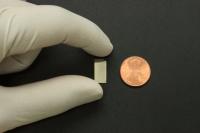Laser or fluorescence microscopes are widely used to study properties of organic or inorganic substances.
The laser makes a specimen emit light, either because the specimen does so naturally or because it has been injected with fluorescent dye.
The trouble is that such dyes, when excited by laser light, generate toxic chemicals that kill living cells.
Now there may be a solution to that problem, thanks to John Lupton, an associate professor of physics, and his colleagues at the University of Utah.
Lupton's idea is a variation of fluorescence microscopy, but involves using an infrared laser to excite clusters of silver nanoparticles placed below the sample being studied.
The particles then form hotspots, which act as beacons, shooting intensely focused white light upward through the overlying sample.
The spectrum or colours of transmitted light reveal information about the composition and structure of the substance examined.
Development of the new system began after a study last May revealed that a beetle from Brazil - a weevil named Lamprocyphus augustus - has shimmering green scales with an ideal 'photonic crystal' structure.
But so far, studying the naturally occurring photonic crystals within the beetle's scales has proved difficult.
Lupton said: 'A normal light microscope generally won't do the trick because visible light is easily scattered by the scales, thwarting efforts to view their internal structure.'

In this image, a tiny portion of a scale from a 'photonic beetle' is viewed using a conventional fluorescence microscope. When blue or ultraviolet laser light is aimed at the scale, most of the light is absorbed but some is re-emitted as fluorescence. Thus, the microscope sees only the surface contour of the scale. The brightest area in the upper right is the thickest part of the shell and emits the most light
'We found that we can put silver nanoparticles beneath the beetle,' he added.
'When illuminated with very intense infrared light, the silver starts to emit white light, but only at very discrete positions.'
Those beacons of intense light were transmitted upward through the beetle scale, allowing scientists to view the scale's internal structure, including tiny differences in the angles of crystal facets, or faces, and the existence of vertical stacks of crystals invisible to other microscope methods.
To the untrained eye, an image created using silver nanoparticle beacons - say, the image of the photonic beetle's scale - looks like a blotchy bunch of spots.
But Lupton said that each of the spots contains a spectrum of colours that reveal information about the scale's internal structure because the light has interacted with that structure.
'There really does not appear to be any other useful technique to look at these natural photonic crystals microscopically,' Lupton said.
'The silver nanoparticle approach to microscopy potentially could be very versatile, allowing us to view other highly scattering samples such as tumour cells, bone samples or amorphous materials in general.'
While Lupton believes the new method will be of interest mainly to biologists, he also says it could be useful for materials science.
For example, silver nanoparticles could be embedded in the carbon-fibre plastic in modern aircraft.
The integrity of the fuselage or other aircraft components could be inspected regularly by exciting the embedded particles with a laser and measuring how much light from the particles is transmitted through the fuselage material.
Changes in transmission of the light would indicate changes in the fuselage structure, a warning that closer inspections of the fuselage are required.

This image shows the same portion of a beetle scale as the previous image. However, this image was made by a fluorescence microscope using a new method. A mirror-like plate containing silver nanoparticles was placed beneath the scale and an infrared laser excited the silver nanoparticles so they act as beacons of white light. The spots in the image are places where the light passed through the scale, providing researchers with information about the scale's internal structure. Almost no light from the beacons passes through the thickest part of the shell (black shadow in upper right) that was the brightest area using a conventional fluorescence microscope




Poll: Should the UK’s railways be renationalised?
I think that a network inclusive of the vehicles on it would make sense. However it remains to be seen if there is any plan for it to be for the...